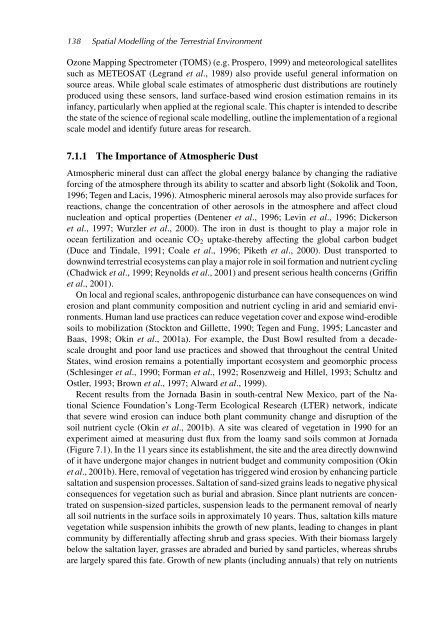1 Spatial Modelling of the Terrestrial Environment - Georeferencial
1 Spatial Modelling of the Terrestrial Environment - Georeferencial
1 Spatial Modelling of the Terrestrial Environment - Georeferencial
Create successful ePaper yourself
Turn your PDF publications into a flip-book with our unique Google optimized e-Paper software.
138 <strong>Spatial</strong> <strong>Modelling</strong> <strong>of</strong> <strong>the</strong> <strong>Terrestrial</strong> <strong>Environment</strong><br />
Ozone Mapping Spectrometer (TOMS) (e.g. Prospero, 1999) and meteorological satellites<br />
such as METEOSAT (Legrand et al., 1989) also provide useful general information on<br />
source areas. While global scale estimates <strong>of</strong> atmospheric dust distributions are routinely<br />
produced using <strong>the</strong>se sensors, land surface-based wind erosion estimation remains in its<br />
infancy, particularly when applied at <strong>the</strong> regional scale. This chapter is intended to describe<br />
<strong>the</strong> state <strong>of</strong> <strong>the</strong> science <strong>of</strong> regional scale modelling, outline <strong>the</strong> implementation <strong>of</strong> a regional<br />
scale model and identify future areas for research.<br />
7.1.1 The Importance <strong>of</strong> Atmospheric Dust<br />
Atmospheric mineral dust can affect <strong>the</strong> global energy balance by changing <strong>the</strong> radiative<br />
forcing <strong>of</strong> <strong>the</strong> atmosphere through its ability to scatter and absorb light (Sokolik and Toon,<br />
1996; Tegen and Lacis, 1996). Atmospheric mineral aerosols may also provide surfaces for<br />
reactions, change <strong>the</strong> concentration <strong>of</strong> o<strong>the</strong>r aerosols in <strong>the</strong> atmosphere and affect cloud<br />
nucleation and optical properties (Dentener et al., 1996; Levin et al., 1996; Dickerson<br />
et al., 1997; Wurzler et al., 2000). The iron in dust is thought to play a major role in<br />
ocean fertilization and oceanic CO 2 uptake-<strong>the</strong>reby affecting <strong>the</strong> global carbon budget<br />
(Duce and Tindale, 1991; Coale et al., 1996; Piketh et al., 2000). Dust transported to<br />
downwind terrestrial ecosystems can play a major role in soil formation and nutrient cycling<br />
(Chadwick et al., 1999; Reynolds et al., 2001) and present serious health concerns (Griffin<br />
et al., 2001).<br />
On local and regional scales, anthropogenic disturbance can have consequences on wind<br />
erosion and plant community composition and nutrient cycling in arid and semiarid environments.<br />
Human land use practices can reduce vegetation cover and expose wind-erodible<br />
soils to mobilization (Stockton and Gillette, 1990; Tegen and Fung, 1995; Lancaster and<br />
Baas, 1998; Okin et al., 2001a). For example, <strong>the</strong> Dust Bowl resulted from a decadescale<br />
drought and poor land use practices and showed that throughout <strong>the</strong> central United<br />
States, wind erosion remains a potentially important ecosystem and geomorphic process<br />
(Schlesinger et al., 1990; Forman et al., 1992; Rosenzweig and Hillel, 1993; Schultz and<br />
Ostler, 1993; Brown et al., 1997; Alward et al., 1999).<br />
Recent results from <strong>the</strong> Jornada Basin in south-central New Mexico, part <strong>of</strong> <strong>the</strong> National<br />
Science Foundation’s Long-Term Ecological Research (LTER) network, indicate<br />
that severe wind erosion can induce both plant community change and disruption <strong>of</strong> <strong>the</strong><br />
soil nutrient cycle (Okin et al., 2001b). A site was cleared <strong>of</strong> vegetation in 1990 for an<br />
experiment aimed at measuring dust flux from <strong>the</strong> loamy sand soils common at Jornada<br />
(Figure 7.1). In <strong>the</strong> 11 years since its establishment, <strong>the</strong> site and <strong>the</strong> area directly downwind<br />
<strong>of</strong> it have undergone major changes in nutrient budget and community composition (Okin<br />
et al., 2001b). Here, removal <strong>of</strong> vegetation has triggered wind erosion by enhancing particle<br />
saltation and suspension processes. Saltation <strong>of</strong> sand-sized grains leads to negative physical<br />
consequences for vegetation such as burial and abrasion. Since plant nutrients are concentrated<br />
on suspension-sized particles, suspension leads to <strong>the</strong> permanent removal <strong>of</strong> nearly<br />
all soil nutrients in <strong>the</strong> surface soils in approximately 10 years. Thus, saltation kills mature<br />
vegetation while suspension inhibits <strong>the</strong> growth <strong>of</strong> new plants, leading to changes in plant<br />
community by differentially affecting shrub and grass species. With <strong>the</strong>ir biomass largely<br />
below <strong>the</strong> saltation layer, grasses are abraded and buried by sand particles, whereas shrubs<br />
are largely spared this fate. Growth <strong>of</strong> new plants (including annuals) that rely on nutrients

















